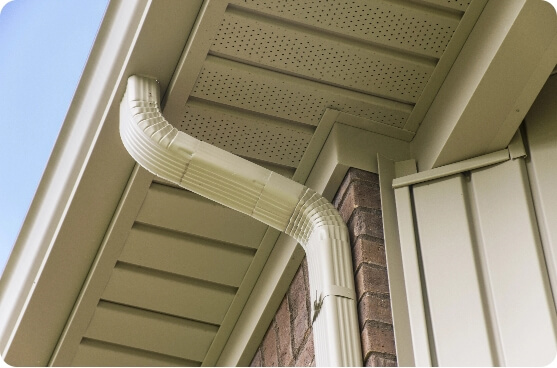How To Choose The Right Gutter System For Your Home

Choosing the right gutter system for your home is an important decision that impacts the overall protection and durability of your property. The correct gutters help direct water away from your home’s foundation, avoiding costly water damage. Learn how to choose gutters and find out the factors to consider when selecting the best system, from materials and sizes to styles and installation.
Understanding the Importance of Gutters for Home Protection
Gutters are vital for managing the flow of rainwater from your roof and directing it away from your home. Without proper gutters, water can accumulate near your foundation, leading to flooding, erosion, and mold growth. A quality gutter system reduces these risks, making your home remain protected and structurally sound.
When gutters are installed correctly, they can also enhance the aesthetic appeal of your home. They come in a variety of materials and styles that complement your home’s architecture. By choosing the right system, you can maintain both the functionality and visual appeal of your exterior.
Proper gutter maintenance is also important to keep your system working effectively. Regular cleaning and repairs prevent blockages and make sure water flows freely, avoiding damage. Neglecting gutters can lead to clogs, which may result in overflow or damage to your roof, walls, and foundation.
Choosing the Right Gutter Material: What You Need to Know
The material you select for your gutters significantly influences their lifespan, maintenance needs, and how they enhance your home's appearance. Common choices include vinyl, aluminum, and copper, each offering distinct advantages and trade-offs.
- Vinyl gutters are popular for being lightweight, cost-effective, and resistant to rust and corrosion. They are easy to install and require minimal upkeep, making them a great option for budget-conscious homeowners. However, vinyl may become brittle or crack in areas with extreme cold or fluctuating temperatures, which can affect its durability over time.
- Aluminum gutters strike a good balance between affordability and performance. They resist rust, are available in a variety of colors and finishes, and handle moderate weather conditions well. Aluminum is generally durable but can dent if impacted by heavy objects like falling branches or hailstones. Their versatility makes them suitable for many climates and architectural styles.
- Copper gutters are a premium choice prized for their exceptional durability and timeless aesthetic. With proper maintenance, copper gutters can last over 50 years and develop a unique patina that enhances curb appeal. While the initial investment is higher and installation typically requires skilled professionals, copper gutters offer long-term value and a distinctive look that few other materials can match.
How to Choose Gutter Size Based on Roof Design
When selecting a gutter system, the size of your roof plays a significant role. Larger roofs with steep slopes or expansive surface areas will require gutters with a larger capacity to handle the increased volume of rainwater. The right gutter size makes it a point that water flows efficiently without overflowing.
A smaller roof may be fine with standard 5-inch gutters, which are common for most homes. However, larger roofs may require 6-inch gutters to prevent clogging and see to it that heavy rainwater does not overflow. Be sure to assess your roof’s surface area and pitch when determining the correct size.
Gutter size also depends on your local climate and the amount of rainfall in your area. Homes in regions with frequent heavy rainfall will need larger gutters to prevent water buildup. If you are unsure, consulting a professional estimator can help you determine the correct gutter size for your specific needs.
Assessing Your Climate: Which Gutter Materials Are Best for Your Area?
The climate in your area plays a key role in determining the best gutter material for your home. For regions with extreme weather, such as heavy snow or rain, durable materials like aluminum or copper are recommended. These materials can withstand the weight of snow and resist corrosion caused by frequent rainfall.
For areas with mild climates, vinyl or steel gutters may be sufficient. Vinyl is ideal for warmer regions where there is little concern about freezing temperatures. Steel gutters, on the other hand, are robust and can handle moderate to severe weather conditions, though they may require occasional maintenance.
In coastal areas, it is important to choose gutters made from corrosion-resistant materials due to saltwater exposure. Aluminum and copper are often the best options in these environments, as they can withstand the corrosive effects of saltwater and humidity.
How Roof Pitch Affects Your Gutter System Selection
The pitch of your roof determines how quickly rainwater will flow off the surface. A steeper roof will cause water to move faster, which may require a larger or more efficient gutter system to catch the excess water. If you have a roof with a steep pitch, you may need wider gutters or additional downspouts to accommodate the fast-moving water.
On the other hand, a roof with a low pitch may not require as large of a gutter system. Water flows more slowly off a flatter roof, so standard-sized gutters may be sufficient. Be sure to consider your roof’s pitch when choosing the appropriate gutter size and style to prevent overflow and water damage.
Additionally, a steeper roof may increase the potential for debris buildup in gutters. Therefore, adding gutter guards or choosing a material that resists clogging is a smart idea to maintain the efficiency of your system.
Gutter Styles Explained: K-Style Vs. Half-Round
There are various styles of gutters to consider, with K-style and half-round being the most popular options. K-style gutters have a modern look and are known for their durability. They feature a flat bottom and back, which allows them to carry more water than half-round gutters, so that they are ideal for homes with larger roofs or in areas with heavy rainfall.
Half-round gutters have a more traditional appearance, with a rounded shape. They are often found in older homes or properties with historical significance. While they may not hold as much water as K-style gutters, they are a great choice for smaller homes or in regions with moderate rainfall.
When choosing between the two styles, consider your home’s aesthetic and functionality needs. K-style gutters are more efficient for handling large volumes of water, while half-round gutters may be more suitable for those looking to preserve the traditional charm of their home.
Choosing Between Seamless and Sectional Gutters
Seamless gutters are a great option for homeowners who want a smooth, uninterrupted look. These gutters are made so that they will match the exact dimensions of your home, reducing the number of joints and seams. Fewer seams mean fewer chances for leaks, making seamless gutters a more reliable and low-maintenance choice.
Sectional gutters are pre-formed and joined together during installation. While they are easier to install and more affordable, they are more prone to leaks due to the seams. However, they can be repaired more easily if damage occurs, making them a good choice for homeowners on a budget.
Both types of gutters come in a variety of materials, so you can choose the best one based on your needs and preferences. If you are looking for a long-term solution with minimal maintenance, seamless gutters may be the right option for you.
How Gutter Guard Systems Can Improve Functionality
Gutter guards are an effective way to improve the functionality and longevity of your gutter system. These guards are designed to prevent leaves, twigs, and other debris from entering your gutters, reducing the need for frequent cleaning. By keeping debris out, gutter guards help water flow freely and prevent blockages.
There are various types of gutter guards, including mesh, screen, and foam inserts. Each type offers different levels of protection against debris and can be chosen based on the specific needs of your home. Mesh guards are particularly effective at filtering out leaves, while foam inserts offer a simple, budget-friendly solution.
While gutter guards are not a substitute for regular maintenance, they can significantly reduce the amount of time and effort required to keep your gutters clean. They are especially useful for homeowners with large trees near their property or in regions with heavy rainfall.
Evaluating Gutter Durability: Which Materials Last the Longest?
Durability is an important factor when choosing a gutter system, as you want a solution that can stand the test of time. Copper gutters, although expensive, are the longest-lasting option, often lasting over 50 years with proper care. Copper is resistant to corrosion and will not deteriorate in the same way as other materials, making it a great investment for the long term.
Aluminum gutters also have a long lifespan, often lasting 20 to 30 years before needing replacement. Aluminum is lightweight, corrosion-resistant, and relatively low-maintenance, making it a practical choice for most homeowners. However, it can dent or bend under extreme pressure, so it may not be suitable for areas with severe weather conditions.
Vinyl gutters, while affordable, are less durable and may need to be replaced every 10 to 15 years. They are vulnerable to cracking or breaking in extreme temperatures, so they are best suited for areas with milder climates. For durability, copper or aluminum gutters are typically the better choice.
The Role of Downspouts in Gutter Performance
Downspouts play a key role in making sure that water flows from the gutters and away from your home. The size and placement of your downspouts will determine how effectively water is directed away from the foundation. Homes with larger roofs or more significant rainfall should have more downspouts to handle the volume of water.
The position of downspouts is equally important. Placing them at the corners of your home or near areas prone to flooding can help redirect water more effectively. Downspouts should also be equipped with extensions that lead water away from your foundation to prevent pooling.
In addition to placement, downspouts should be cleaned regularly to prevent clogs. A blockage in the downspout can cause water to back up into the gutters, leading to overflow and potential damage to your roof and walls.
The Cost of Different Gutter Materials and Systems
The cost of your gutter system will depend on several factors, including the material, size, style, and complexity of installation. Vinyl gutters are typically the most affordable option, while copper gutters are the most expensive. Aluminum gutters offer a good balance of cost and durability.
Installation costs can also vary based on the type of system you choose. Seamless gutters generally cost more to install due to the custom fabrication required. Sectional gutters, while more affordable, may require more maintenance over time, increasing long-term costs.
While the initial cost is an important consideration, it is also best to factor in the long-term benefits of durability and low maintenance. In the end, investing in a higher-quality gutter system may save you money in repairs and replacements over time.
The Impact of Gutter Color and Style on Your Home's Appearance
The color and style of your gutters can influence the overall appearance of your home. Gutters come in various colors, and selecting one that complements your home’s exterior will create a cohesive look. A well-chosen color can blend the gutters seamlessly with your roofing, siding, and trim, enhancing the home’s curb appeal.
While many homeowners opt for neutral shades like white or gray, darker colors can help hide dirt and weathering over time. Additionally, if you have a more modern home, you may want to consider a sleek, contemporary gutter style that complements the clean lines of your architecture. Selecting a style that complements your home’s design will make a lasting impression.
Consider also how the gutter material will age. For example, copper gutters will naturally develop a patina over time, which can add to their character. In contrast, vinyl or aluminum gutters are more likely to retain their original color unless exposed to harsh elements for prolonged periods.
Maintaining Your Gutter System: What You Need to Know
Regular maintenance is key to keeping your gutters functioning properly. Cleaning your gutters at least twice a year will prevent debris buildup and make sure that water flows freely. Neglecting to clean gutters can result in clogs, which may cause water to overflow and damage your roof and foundation.
In addition to cleaning, inspect your gutters periodically for signs of wear and tear. Look for cracks, rust, or loose sections that may need repairs. Keeping your gutters in good condition will prolong their lifespan and protect your home from water damage.
Consider hiring a professional gutter cleaning service if you are unable to maintain your gutters yourself. A professional service can see to it that your gutters are cleaned thoroughly and that any repairs are completed efficiently, saving you time and effort.
Protect Your Home with Professional Home Exterior Services
Choosing the right gutter system is vital for protecting your home from water damage. At Honey Do Men, we specialize in home exterior services, including gutter installation and maintenance. Let our expert team help you select the best system for your needs to safeguard your property and improve its curb appeal.
Contact us today to schedule a consultation. Our team is ready to assist you in safeguarding your home from the elements.




